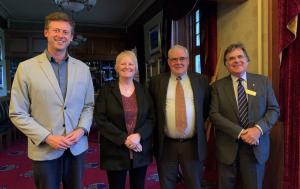Speaker Jim Douglas
Tue, Dec 18th 2018 at 7:00 pm - 8:30 pm
Member Jim Douglas, a former maths teacher, prompted his audience into a numbers game – which left most of them either confused or dumbstruck.
His talk was based on “Fermat’s Last Theorem”, possibly the most famous mathematical equation of all time identified in the 1600s by French eminent mathematician Pierre de Fermat.
However, the puzzle had been around for much longer, first proposed around 250 AD by Diophantus, who first began the business of solving equations with whole numbers.
His book on the subject travelled widely from the Middle East and through most of Europe.
1600 years later, when Fermat died, his son found his father’s copy of Diophantus’ book which had a plethora of notes and theorems scribbled all over the wide margins. One of which seemed to be a proof of the famous theorem so far unproven.
The theorem at the centre of all this mathematical brainpower throughout the centuries then became known as Fermat’s Last Theorem.
(Are you all with me so far? If so, would someone explain it to me!)
A German mathematician, Euler, then spent much of the 18th century attempting to prove the equation but apparently gave up, as did other contemporaries.
In 1897 a German doctor provided an award of 100,000 German Marks as a prize to anyone who could prove the theorem. It would be available for 100 years. Two years before the offer expired, in 1995, English mathematician Sir Andrew Wiles claimed to have unearthed the proof required. It was decided that his work was near enough to be considered proof and he was awarded the prize, then valued at £30,000. He also secured £500,000 when his work was rewarded with the mathematical world’s equivalent of a Nobel Prize.
Prior to all that, in the early 1900s, G.H.Hardy, the most prominent maths expert of his time, received a letter from a poverty-stricken young Indian accounts clerk who provided a wealth of investigation on theorems and equations, including the Fermat version. Hardy knew talent when he saw it and arranged for Srinivasa Ramanujan to travel to Britain in 1914 and work in Cambridge.
During his time in Britain, it was generally recognised the Ramanujan was probably the greatest and most inventive mathematician who had ever existed. Plagued by ill health all his life, the Indian genius died back in Madras at the age of 32. His life and work was the basis for a recent movie “The Man Who Knew Infinity”.
With the numbers game seemingly exhausted, it remained for Simon Baldwin to propose a vote of thanks for an amazing insight into issues fairly foreign to most of those present. Trying to prove the impossible, he quoted, is a gift held by only a handful of people in history.
But…the numbers game was not yet over for the evening.
Club administration secretary Grace Morris persuaded her fellow members to join in a rendition of “The Twelve Days of Christmas”. She had compiled a storyline which was interspersed with the sung verses. It proved highly entertaining, containing as it did a variety of comments on everything from Brexit to unwanted Christmas presents.
'What We Do' Main Pages:

.jpg)


